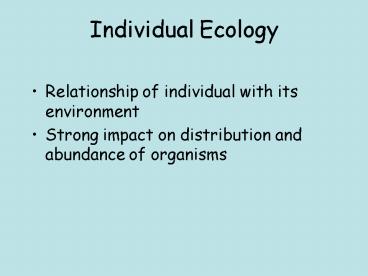Individual Ecology - PowerPoint PPT Presentation
1 / 38
Title:
Individual Ecology
Description:
Ecology - concerned with distribution of organisms ... Colder - MR. shiver. Warmer - MR. heart rate and blood flow to skin. High temps - High Blood Flow ... – PowerPoint PPT presentation
Number of Views:151
Avg rating:3.0/5.0
Title: Individual Ecology
1
Individual Ecology
- Relationship of individual with its environment
- Strong impact on distribution and abundance of
organisms
2
Physiological Ecology
- Ecology - concerned with distribution of
organisms - Physiology - concerned with function of organisms
- Combined how function of organisms affects their
distribution
3
Microhabitat
- Important factors
- Altitude
- Aspect
- Vegetation life
- form
- Ground Color
- Objects in the
- environment (e.g.,
- boulder, burrows)
4
Microhabitats
5
Thermal Microclimates
6
Temperature Relations
- Most species perform best in narrow range of
temps - Enzymes have optimal temperatures
- Temperature extremes impair enzyme functioning
7
Enzymatic Variation
- Range of conditions individual can function in
- Range more narrow than environmental variation
- Individual needs to regulate body temp to stay in
the acceptable range - Acclimation (physiological not genetic changes)
8
Enzyme Activity in Trout
- Two forms of acetylcholinesterase
- Rainbow trout native to cool streams
- Winter temps 0-4C
- Summer temps 20
9
Heat Transfer
- Conduction - heat transfer between bodies in
direct physical contact - Convection - Transfer of heat between a solid and
a moving fluid (air or water) - Radiation - transfer of heat between objects
without contact - Evaporation - heat lost as water evaporates
10
(No Transcript)
11
Heat Transfer
- Conduction
- Convection
- Radiation
- Evaporation
- Conduction
- Convection
- Radiation
12
(No Transcript)
13
How Do Individuals Regulate Temperature?
14
Endothermy vs. Ectothermy
Endotherms
generate their own heat
rely on environmental sources
Ectotherms
15
Some (more) Thermal Jargon
Homeotherms
maintain a constant Tb
Poikilotherms
Tb varies with environmental T
16
Temperature Regulation in Plants
- Almost all are ectotherms
- Have many adaptations for reducing and increasing
heat storage
17
Reducing Heat
x
Heat Stored Heat produced Heat In - Heat Out
- Options?
- ? radiation in, conduction in
- ? convection away
- ? evaporation?
- No, conserve water
18
Decrease Radiation Gain
- Reflective surface
- White plant-hairs
- Orient parallel to sunlight
19
Reduce heat gain
- ? conductive gain
- Limit contact with ground
- ? convection away
- ? surface area for wind
20
Desert Plants
21
Increasing heat storage- plants
x
Heat Stored Heat produced Heat In - Heat Out
- Options
- ? radiation in, conduction in
- ?convective cooling
- ? evaporative cooling
22
23
Increase Heat
- Dark pigments
- Orient leaves perpendicular to sunlight
- Grow close to ground
- ? radiation and conduction
- ? convective cooling
24
Skunk Cabbage
25
Thermoregulation in Ectothermic Animals
- Alter gain from radiation
- Seek sun and shade
- Pigmentation change
- Alter conduction
- Lay flat / Push away
- Alter convective cooling
26
Alter Evaporative Cooling
27
Temperature Regulation in Endotherms
28
Endotherms
- Still do behavioral regulations
- Internal heat production becomes most important
29
Thermal Neutral Zone
- Range of environmental temps at which metabolic
rate doesnt change - Colder - ? MR
- shiver
- Warmer - ? MR
- ? heart rate and blood flow to skin
30
High temps - High Blood Flow
? Evaporative cooling
? Convective cooling
31
Thermal neutral zone
32
Allens rule
- Endothermic species from colder climates will
have shorter appendages, ears, etc
33
Bergmans Rule
- Endothermic individuals will be bigger in colder
climates - Decrease SAV
34
Heterotherms
- Some endotherms do not always maintain a constant
Tb - Torpor
- Hibernation
- Estivation
35
Torpor
36
Marine Mammal Thermoregulation
37
Desert Gazelle
38
Major Conclusion
- Temperature is VERY important factor in
determining the distribution of organisms - Kelp
- Coral 20 0C
- No moose in Florida
- No lizards in Maine































